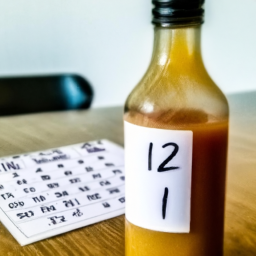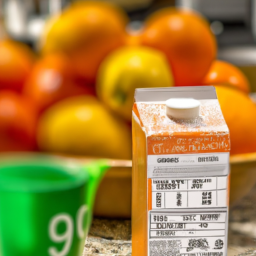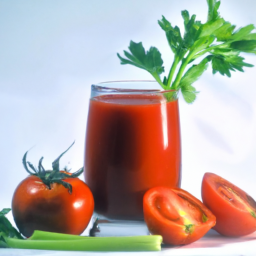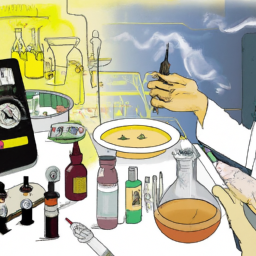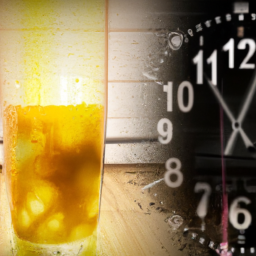Well look who’s back on the wellness wagon! That’s right, it’s me. Like many health enthusiasts, I’ve been embracing the latest health trend of pressed juice.
But, as I sip on my green elixir, I can’t help but wonder, how long is this juice good for?
Pressed juice, as the name suggests, is made by pressing fruits and vegetables to extract their juice. Unlike store-bought juice, this juice is not pasteurized, meaning it retains its nutrients and enzymes. However, this also means it has a shorter shelf life.
So, as someone who is trying to be health-conscious, it’s important to know how long I have to consume this juice before it goes bad.
In this article, I’ll be diving deep into the world of pressed juice to answer the age-old question, how long is pressed juice good for?
Key Takeaways
- The shelf life of pressed juice varies depending on several factors such as the ingredients used, the storage method, and the presence of preservatives.
- Cold-pressed juice can last up to 72 hours in the fridge.
- Signs of spoilage include changes in color, texture, or smell, as well as mold or visible particles in the juice.
- Proper storage and timely consumption can prevent potential health risks associated with consuming expired pressed juice.
What is Pressed Juice?
Do you know what pressed juice is and how it can benefit your health? Pressed juice is a type of juice that’s extracted from fruits and vegetables using a hydraulic press or a centrifugal juicer. The main difference between these two methods is that the hydraulic press uses pressure to extract the juice, while the centrifugal juicer uses high-speed spinning blades to separate the juice from the pulp.
One of the advantages of pressed juice is that it contains more nutrients than fresh fruit. This is because the process of juicing releases the vitamins, minerals, and enzymes from the fruits and vegetables, making them more easily absorbed by the body.
Additionally, cold press juice is more nutritious than juice made with a centrifugal juicer because it retains more of the nutrients due to its slow, gentle juicing process.
Now, let’s move on to understanding the shelf life of pressed juice.
Understanding the Shelf Life
Discover how much time you have to savor your fresh pressed juice with its natural nutrients and flavors at their peak! The shelf life of pressed juice varies depending on several factors such as the ingredients used, the storage method, and the presence of preservatives.
Here are three ways to preserve your pressed juice and extend its shelf life:
-
Cold-pressed: This method uses a hydraulic press to extract juice from fruits and vegetables, which preserves nutrients and enzymes and slows down the oxidation process. Cold-pressed juice can last up to 72 hours in the fridge.
-
Pasteurization: This method heats the juice to a high temperature for a short period to kill bacteria and extend shelf life. However, pasteurization also destroys some of the nutrients and enzymes and alters the taste and texture of the juice. Pasteurized juice can last up to 30 days in the fridge.
-
HPP (High-pressure processing): This method uses high pressure to kill bacteria and extend shelf life without heating the juice. HPP preserves the nutrients and enzymes and maintains the taste and texture of the juice. HPP juice can last up to 45 days in the fridge.
Understanding the ways to preserve your pressed juice and the effects of oxidation is crucial to ensure that you enjoy your juice at its best. But how long does pressed juice last? Let’s find out in the next section.
How Long Does Pressed Juice Last?
As a juice enthusiast, I’m always curious about the shelf life of different types of juice and the signs of spoilage.
It’s important to know how long pressed juice lasts to ensure its quality and safety.
Factors like temperature, processing methods, and preservatives can affect the shelf life of juice, and recognizing signs of spoilage can prevent potential health risks.
Shelf Life of Different Types of Juice
The clock is ticking on the freshness of your favorite pressed juices, as each type has its own unique shelf life. To ensure that your juices stay fresh for as long as possible, it’s important to understand the shelf life of each type.
Here are five types of juice and their respective shelf lives:
- Citrus juice: 2-3 days
- Green juice: 3-4 days
- Root vegetable juice: 3-4 days
- Fruit juice: 4-5 days
- Nut milk: 4-5 days
It’s important to note that the shelf life of pressed juice can be extended with proper juice preservation techniques and juice storage conditions. For example, storing juice in airtight containers in the fridge can help to slow down the oxidation process that leads to spoilage.
Additionally, adding lemon juice or vitamin C powder to your juice can help to preserve it for longer. However, even with proper preservation techniques, it’s important to keep an eye out for signs of spoilage, such as changes in color, texture, or smell.
As your pressed juices start to approach their expiration dates, signs of spoilage may begin to appear. In the next section, we’ll take a closer look at these signs and what they mean for the freshness and safety of your juice.
Signs of Spoilage
If you’re wondering how to tell if your pressed juice is no longer safe to drink, pay attention to these signs of spoilage. One of the most common indicators is a change in color. If the juice starts to turn brown or green, it’s a sign that it’s gone bad. Another sign to look out for is a sour or rancid smell. If the juice smells off or unpleasant, it’s best to throw it away. Finally, if you notice any mold or visible particles in the juice, it’s a definite indication that it’s no longer safe to consume.
To prevent any potential health risks, it’s important to follow some prevention tips to ensure that your pressed juice stays fresh for as long as possible. One way to extend the shelf life of your juice is to store it in airtight containers in the refrigerator. Additionally, try to consume your juice within 3-5 days of pressing it to avoid any potential spoilage. By following these tips, you can enjoy your freshly pressed juice with peace of mind knowing that it’s safe to drink. Next, let’s discuss some tips for extending the shelf life of your pressed juice.
Tips for Extending the Shelf Life
Hey, did you know that storing your pressed juice in an airtight container in the fridge can help extend its shelf life? This is because oxygen is one of the main factors that contribute to the spoilage of juice. Vacuum sealing is another effective way to extend the shelf life of your pressed juice. By removing the air from the bottle, you’re preventing oxidation and slowing down the growth of bacteria that can cause spoilage.
Refrigeration techniques also play a crucial role in preserving the freshness of your pressed juice. You should always store your juice in the fridge as soon as possible after juicing. Keep it away from direct sunlight and other sources of heat. Make sure that the fridge is set to a temperature of 40°F or lower.
By following these tips, you can extend the shelf life of your pressed juice and enjoy it for a few more days. But can you freeze pressed juice? Let’s find out in the next section.
Can You Freeze Pressed Juice?
Did you know that you can freeze your freshly pressed juice to preserve its nutrients and flavors for later use? Freezing methods vary depending on the type of juice and equipment used, so it’s important to follow proper storage guidelines to avoid spoilage and maintain quality.
One popular method is to pour your juice into ice cube trays and freeze them. Once frozen, transfer the cubes into a freezer-safe container and label it with the date. This allows for easy portion control and thawing when you want to enjoy your juice. Another option is to freeze the juice in airtight containers or freezer bags. Just make sure to leave enough headspace for expansion and seal tightly to prevent freezer burn.
Alternative storage options include refrigeration and vacuum sealing, but keep in mind that these methods will not extend the shelf life as long as freezing will.
When it comes to consuming your frozen juice, it’s important to note that the texture may change and separation may occur upon thawing. However, the nutrients and flavors should still be preserved.
But what about expired pressed juice? Is it safe to drink? Let’s explore that in the next section.
Is It Safe to Drink Expired Pressed Juice?
In the previous subtopic, we discussed whether or not you can freeze pressed juice. Now, let’s talk about the safety of consuming expired pressed juice.
As a juice enthusiast, I’ve often found myself wondering if it’s safe to drink juice that has gone past the expiration date. While some people may think it’s okay to consume expired juice, it’s important to know the potential health hazards that come with it.
To prevent spoilage of pressed juice, it’s crucial to store it properly. Once a juice has been opened, it should be kept refrigerated and consumed within a few days. If the juice has been left out at room temperature for an extended period of time, it’s likely to spoil.
Here are some ways to detect spoilage and prevent consuming expired pressed juice:
- Check the expiry date on the bottle or container.
- Look for signs of spoilage such as a change in color, texture, or smell.
- If the juice tastes sour or has a strange flavor, it’s likely that it has gone bad.
It’s important to avoid drinking spoiled juice as it can lead to various health hazards. Consuming expired pressed juice can cause food poisoning, which can result in stomach cramps, diarrhea, and nausea. Drinking juice that has gone bad can also lead to bacterial infections that can be harmful to your health.
Therefore, it’s best to play it safe and discard any juice that has gone past its expiration date or shows signs of spoilage.
Moving on to the next section, let’s discuss the risks of drinking spoiled juice.
Risks of Drinking Spoiled Juice
Consuming spoiled juice can lead to serious health risks, so it’s important to recognize the signs of spoilage and dispose of any expired or questionable juice to avoid potential food poisoning and health risks. Some of the signs to look out for include a change in color, a sour smell, and an off-taste. If you notice any of these signs, it’s best to err on the side of caution and throw away the juice.
One of the most common health risks associated with drinking spoiled juice is an upset stomach, which can lead to stomach cramps, diarrhea, and nausea. Additionally, drinking contaminated juice can increase your risk of bacterial infections, especially if you have a weakened immune system.
It’s important to always check the expiration date on your pressed juice and to store it properly to avoid spoilage.
Drinking fresh pressed juice, on the other hand, has many benefits for your health. It can provide your body with essential vitamins, minerals, and antioxidants. So, it’s important to make sure your pressed juice is fresh and not expired to reap these benefits.
Benefits of Consuming Fresh Pressed Juice
Sipping on a chilled glass of freshly squeezed juice is like drinking in the sunshine and nutrients from a garden. The health benefits and nutritional value of consuming fresh pressed juice are numerous. Not only does it provide a quick and convenient way to consume a variety of fruits and vegetables, but it also contains a high concentration of vitamins, minerals, and antioxidants that are essential for maintaining a healthy body.
To better understand the benefits of consuming fresh pressed juice, here is a table outlining some of the key nutrients found in popular fruits and vegetables used in juicing:
| Fruit/Vegetable | Nutrients |
|---|---|
| Apple | Vitamin C, fiber, antioxidants |
| Carrots | Vitamin A, potassium, antioxidants |
| Kale | Vitamin K, calcium, iron, antioxidants |
| Spinach | Vitamin A, iron, folate, antioxidants |
By incorporating a variety of fruits and vegetables into your juicing routine, you can reap the benefits of a diverse range of nutrients. However, it is important to note that consuming fresh pressed juice should not replace whole fruits and vegetables in your diet. While it can provide a convenient way to consume additional nutrients, it lacks the fiber and other important components found in whole foods.
Moving on to the next section, let’s address some common misconceptions about pressed juice.
Common Misconceptions About Pressed Juice
Don’t be fooled by the myths surrounding fresh pressed juice – it’s time to set the record straight. Many misleading claims have been made about the benefits and shelf life of pressed juice. Here are some common misconceptions that need to be debunked:
- Pressed juice can’t cure all illnesses.
- Not all pressed juice is created equal.
- Pressed juice isn’t a complete meal replacement.
- Pressed juice doesn’t last for weeks in the fridge.
While fresh pressed juice does offer numerous health benefits, it is not a cure-all for every ailment. Additionally, not all pressed juices are created equal. The nutrient content and quality can vary greatly depending on the ingredients and method of extraction. It’s important to do your research and choose a reputable source for your pressed juice.
Another common misconception is that pressed juice can replace a complete meal. While it can provide a boost of nutrients, it lacks essential macronutrients like protein and fiber. It’s important to supplement your diet with other sources of nutrition to ensure you’re meeting your body’s needs.
Finally, pressed juice has a short shelf life and should be consumed within a few days to ensure maximum freshness and nutrient content. Don’t fall for the myths surrounding pressed juice – enjoy it for its true health benefits and keep it fresh and delicious.
Frequently Asked Questions
What is the best way to store pressed juice to ensure it stays fresh for the longest amount of time?
Juice storage tips are important for freshness preservation. The best way to keep pressed juice fresh is to store it in an airtight container in the refrigerator. Adding lemon juice can also help extend its shelf life. Trust me, your juice will stay fresh forever! (hyperbole) …well, not really forever, but it will certainly last longer than if left exposed to air and light.
Can you mix different types of pressed juice together to create new flavors?
Juice mixing techniques allow for flavor experimentation. Combining different types of pressed juice creates unique taste profiles. However, it’s important to consider the acidity and sugar content of each juice to ensure a balanced blend.
Is there a difference in the shelf life of pressed juice made from fruits versus vegetables?
When comparing the shelf life of pressed juice made from fruits versus vegetables, there is a difference. Vegetables tend to have a longer shelf life due to their lower sugar content and higher nutrient retention.
Should you avoid consuming pressed juice if you have a weak immune system or are pregnant?
Oh, definitely avoid pressed juice if you have a weak immune system or are pregnant. Who needs those immune system benefits and extra nutrients anyway? It’s not like they’re important. (Note: This response contains irony)
How does the nutritional value of pressed juice compare to whole fruits and vegetables?
When comparing the nutritional value of pressed juice to whole fruits and vegetables, juice may lack fiber but it can provide higher nutrient absorption. Juice vs. smoothies depends on personal preference and dietary needs.
Conclusion
In conclusion, pressed juice is a fresh and healthy option for those seeking a nutrient-rich beverage. It’s important to understand its shelf life and how to properly store it to maximize its benefits.
As mentioned earlier, the shelf life of pressed juice is typically three to five days, but this can vary depending on the ingredients used and the storage methods employed. One interesting statistic to note is that the global market for pressed juice is expected to reach $4.8 billion by 2024, indicating the growing popularity of this beverage.
However, it’s important to exercise caution when consuming expired juice as it can pose health risks. By following proper storage guidelines and consuming fresh juice, individuals can reap the many benefits of this healthful beverage. Remember to always check the expiration date and use your senses to determine if the juice has spoiled.
Overall, pressed juice can be a delicious and nutritious addition to a healthy lifestyle.
Ilana has been a vegan for over 10 years. She originally made the switch for health reasons, but soon found herself becoming more and more passionate about the ethical and environmental implications of a vegan lifestyle. Ilana is the author of The Graceful Kitchen, a blog all about veganism. She loves to cook up delicious and nutritious vegan meals, and share her recipes with others who are interested in leading a cruelty-free life. Ilana is also a strong advocate for using whole foods as the foundation of a healthy diet, and believes that going vegan is one of the best ways to achieve this.
